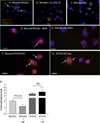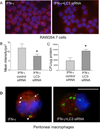Helminth infection impairs autophagy-mediated killing of bacterial enteropathogens by macrophages
- PMID: 22732589
- PMCID: PMC3423331
- DOI: 10.4049/jimmunol.1200484
Helminth infection impairs autophagy-mediated killing of bacterial enteropathogens by macrophages
Abstract
Autophagy is an important mechanism used by macrophages to kill intracellular pathogens. The results reported in this study demonstrate that autophagy is also involved in the macrophage killing of the extracellular enteropathogen Citrobacter rodentium after phagocytosis. The process was significantly impaired in macrophages isolated from mice chronically infected with the helminth parasite Heligmosomoides polygyrus. The H. polygyrus-mediated inhibition of autophagy was Th2 dependent because it was not observed in macrophages isolated from helminth-infected STAT6-deficient mice. Moreover, autophagy of Citrobacter was inhibited by treating macrophages with IL-4 and IL-13. The effect of H. polygyrus on autophagy was associated with decreased expression and processing of L chain protein 3 (LC3), a key component of the autophagic machinery. The helminth-induced inhibition of LC3 expression and processing was STAT6 dependent and could be recapitulated by treatment of macrophages with IL-4 and IL-13. Knockdown of LC3 significantly inhibited autophagic killing of Citrobacter, attesting to the functional importance of the H. polygyrus-mediated downregulation of this process. These observations reveal a new aspect of the immunosuppressive effects of helminth infection and provide mechanistic insights into our earlier finding that H. polygyrus significantly worsens the in vivo course of Citrobacter infection.
Figures







Similar articles
-
Concurrent infection with an intestinal helminth parasite impairs host resistance to enteric Citrobacter rodentium and enhances Citrobacter-induced colitis in mice.Infect Immun. 2005 Sep;73(9):5468-81. doi: 10.1128/IAI.73.9.5468-5481.2005. Infect Immun. 2005. PMID: 16113263 Free PMC article.
-
Helminth-induced alterations of the gut microbiota exacerbate bacterial colitis.Mucosal Immunol. 2018 Jan;11(1):144-157. doi: 10.1038/mi.2017.20. Epub 2017 Mar 29. Mucosal Immunol. 2018. PMID: 28352104 Free PMC article.
-
Helminth-primed dendritic cells alter the host response to enteric bacterial infection.J Immunol. 2006 Jan 1;176(1):472-83. doi: 10.4049/jimmunol.176.1.472. J Immunol. 2006. PMID: 16365440 Free PMC article.
-
Alternatively activated macrophages in intestinal helminth infection: effects on concurrent bacterial colitis.J Immunol. 2007 Oct 1;179(7):4721-31. doi: 10.4049/jimmunol.179.7.4721. J Immunol. 2007. PMID: 17878371 Free PMC article.
-
Toxoplasma Co-infection Prevents Th2 Differentiation and Leads to a Helminth-Specific Th1 Response.Front Cell Infect Microbiol. 2017 Jul 25;7:341. doi: 10.3389/fcimb.2017.00341. eCollection 2017. Front Cell Infect Microbiol. 2017. PMID: 28791259 Free PMC article.
Cited by
-
The syndemics of childhood diarrhoea: a biosocial perspective on efforts to combat global inequities in diarrhoea-related morbidity and mortality.Glob Public Health. 2014;9(7):841-53. doi: 10.1080/17441692.2014.924022. Epub 2014 Jul 8. Glob Public Health. 2014. PMID: 25005132 Free PMC article.
-
Development of fatal intestinal inflammation in MyD88 deficient mice co-infected with helminth and bacterial enteropathogens.PLoS Negl Trop Dis. 2014 Jul 10;8(7):e2987. doi: 10.1371/journal.pntd.0002987. eCollection 2014 Jul. PLoS Negl Trop Dis. 2014. PMID: 25010669 Free PMC article.
-
Hydatid fluid from Echinococcus granulosus induces autophagy in dendritic cells and promotes polyfunctional T-cell responses.Front Cell Infect Microbiol. 2024 May 16;14:1334211. doi: 10.3389/fcimb.2024.1334211. eCollection 2024. Front Cell Infect Microbiol. 2024. PMID: 38817444 Free PMC article.
-
The Ligand Binding Domain of the Cell Wall Protein SraP Modulates Macrophage Apoptosis and Inflammatory Responses in Staphylococcus aureus Infections.Molecules. 2025 Mar 5;30(5):1168. doi: 10.3390/molecules30051168. Molecules. 2025. PMID: 40076391 Free PMC article.
-
Potential role of host autophagy in Clonorchis sinensis infection.Parasitol Res. 2024 Oct 23;123(10):359. doi: 10.1007/s00436-024-08382-z. Parasitol Res. 2024. PMID: 39441249
References
-
- Nokes C, Cooper E, Robinson B, Bundy D. Geohelminth infection and academic assessment in Jamaican children. Trans R Soc Trop Med Hyg. 1991;2:272–273. - PubMed
-
- Crompton D, Nesheim M. Nutritional impact of intestinal helminthiasis during the human life cycle. Annual Review of Nutrition. 2002;22:35–59. - PubMed
Publication types
MeSH terms
Substances
Grants and funding
LinkOut - more resources
Full Text Sources
Molecular Biology Databases
Research Materials
Miscellaneous

